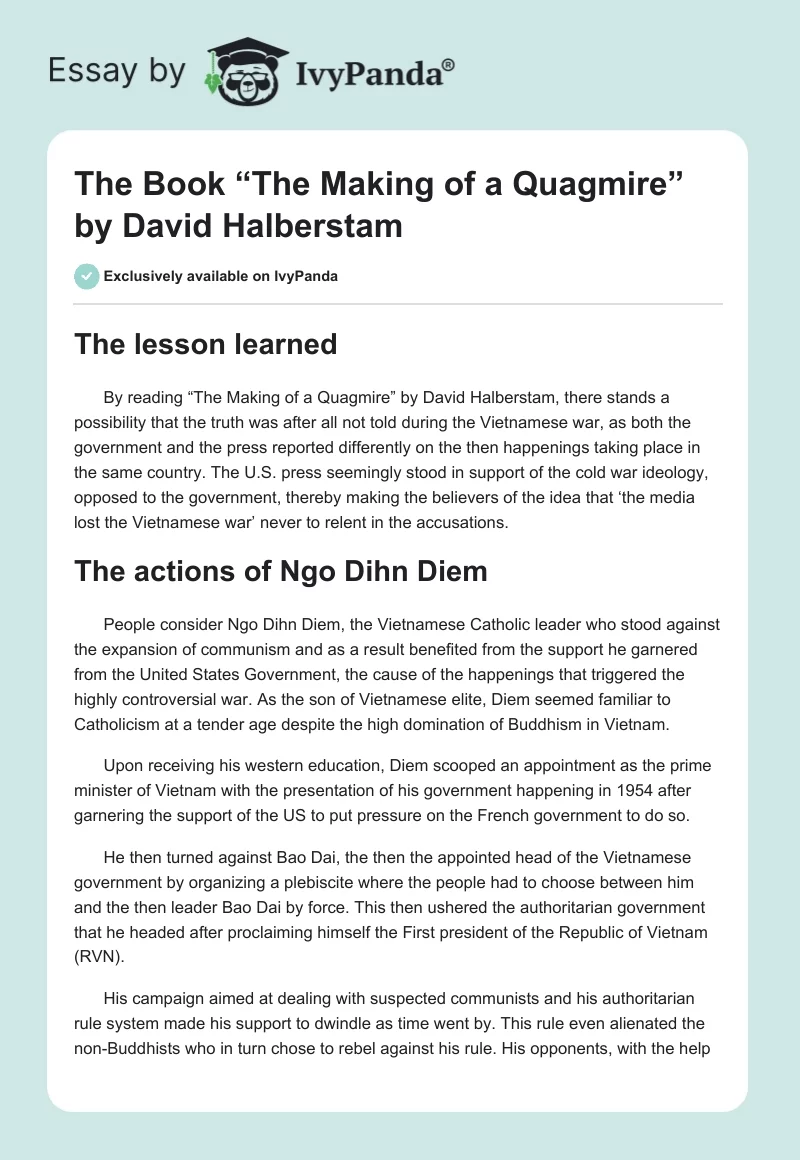The lesson learned
By reading “The Making of a Quagmire” by David Halberstam, there stands a possibility that the truth was after all not told during the Vietnamese war, as both the government and the press reported differently on the then happenings taking place in the same country. The U.S. press seemingly stood in support of the cold war ideology, opposed to the government, thereby making the believers of the idea that ‘the media lost the Vietnamese war’ never to relent in the accusations.
The actions of Ngo Dihn Diem
People consider Ngo Dihn Diem, the Vietnamese Catholic leader who stood against the expansion of communism and as a result benefited from the support he garnered from the United States Government, the cause of the happenings that triggered the highly controversial war. As the son of Vietnamese elite, Diem seemed familiar to Catholicism at a tender age despite the high domination of Buddhism in Vietnam.
Upon receiving his western education, Diem scooped an appointment as the prime minister of Vietnam with the presentation of his government happening in 1954 after garnering the support of the US to put pressure on the French government to do so.
He then turned against Bao Dai, the then the appointed head of the Vietnamese government by organizing a plebiscite where the people had to choose between him and the then leader Bao Dai by force. This then ushered the authoritarian government that he headed after proclaiming himself the First president of the Republic of Vietnam (RVN).
His campaign aimed at dealing with suspected communists and his authoritarian rule system made his support to dwindle as time went by. This rule even alienated the non-Buddhists who in turn chose to rebel against his rule. His opponents, with the help of the Democratic Republic of Vietnam (DRV), formed the national Liberation Front of South Vietnam (NLF), which aimed at overthrowing his government.
As Halberstam reported, the alleged killing of 130,000 Catholics by the Buddhists in 1840 stands out as a thing taken to as an excuse by Diem to treat the Buddhists badly considering that one of his ancestors was a victim in the massacre (56). As pressure intensified in Vietnam, the United States then allowed the staging of the coup against Ngo Dihn Diem in 1963, followed by his assassination the next day together with one of his brothers.
Halberstam gives a description of the happenings on the parade day “On our way to the parade, we noticed a curious phenomenon: the police were turning away thousands of people…After the parade . Jim Robinson of NBC…pointed out that the public had been barred but [Ambassador] Nolting refused to believe him” (145). This controversy illustrates the manner in which the government officials and the press viewed the events in Vietnam differently.
The Press or the Government
Considering that the media and the government gave very conflicting reports about the same happenings, it proves hard therefore to deduce satisfactorily on whom to declare as right and wrong between the press and the government in giving the account of the events as they happened.
However, by considering the commentary about a single happening during the war, it seems possible to come up with the deemed motives of either sides and therefore conclude as to who said the truth as opposed to who. For instance, the similarity that the descriptions given by Halberstam and that of some government officials proves that since the media had little to benefit from their reports, they might after all have aired true reports all along.
The description of the battlefield of Ap Bac by Halberstem and that of general Harkins provides a working example where a South Vietnamese armored and heliborne force was badly mauled by a smaller Vietcong Unit. General Harkins declared that ‘We’ve got them in a trap” (78) a sentiment that echoes Halberstam. General Harkin’s superior later was on record saying “as I understood it, was a Vietnamese victory” (79).
Yet, this was a defeat that everyone knew except for those who are deemed to have been in dire need of the knowledge. It is apparently right to conclude that Halberstam gives a finely honed description of the events in the war as they stood then.
Works Cited
Halberstam, David. The Making of a Quagmire. New York: Random House, 1965.


